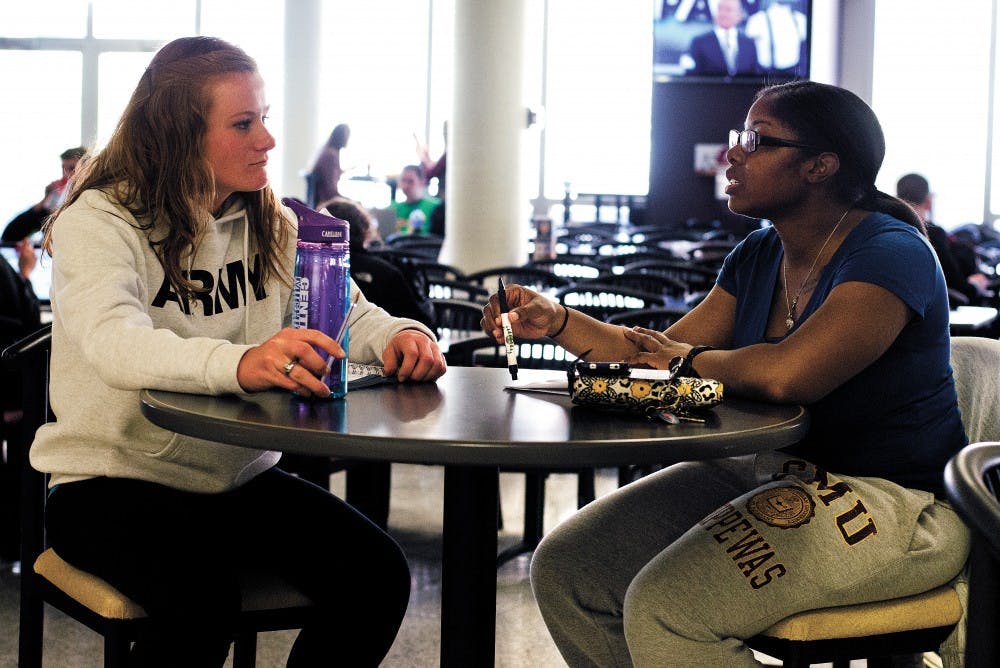PAVE program connects veterans with resources

Clio sophomore Cate Sather, left, talks with Pontiac senior Ebony Thompson March 24 at the Down Under Food Court in the Bovee University Center.
After serving as a combat veteran and making the transition to civilian life, Roseville junior Nick Badgero said he wished he had a resource in other student veterans.
Starting in 2013, the Peer Advisers for Veteran Education program has worked to fill that need, connecting incoming student veterans or people receiving Veteran Affair benefits with other veterans who are upperclassmen.
“The biggest thing is you don’t want vets to isolate themselves immediately,” said Badgero, who is one of the managers of the program in addition to being a peer adviser. “I did that when I came here. I had a six-month stint where I didn’t really talk to anyone and that’s not really healthy or good, but it happens.”
Anyone in the military or using VA benefits is eligible for PAVE. The program is meant to help veterans make a healthy transition out of the military, and provide them with resources to navigate college life. The PAVE office is located in the Veterans' Resource Center in Warriner Hall.
“There is stuff about the military that I would have never known about it if I didn’t have her to talk to,” said Clio sophomore Caitlin Sather. “I like it because I can talk to Ebony about different options for contracting.”
Sather is new to the program and the military, and has five years left in her contract with the National Guard. Her peer adviser, Pontiac senior Ebony Thompson, has been enlisted for three and a half years and also is contracted with ROTC, making her a Simultaneous Member cadet. She hopes to commission this May after graduation, she said.
A short questionnaire for PAVE is available at the Veterans’ Resource center for anyone interested in joining and receiving VA benefits. The single page of questions is filled out by peer advisers and students interested in utilizing the program in order to make compatible pairs in regards to things like military background, college majors and common interests.
“The best part about the program is that it just welcomes vets and connects them to campus,” said Senior Isaac Smith, who is another manager of PAVE. “The simple act of welcoming someone to your institution makes them a lot more successful.”
Badgero said PAVE is different from other organizations meant to support veterans, such as Student Veterans of America, because of its peer-to-peer nature. He is a member of both and said each organization has their place, but prefers PAVE because of its personal approach to supporting veterans.
“A veteran needs more than just getting thrown into a group of people,” Badgero said. “If one specific person makes an effort to get to know you, it’s a little better.”
PAVE is a service offered to veterans in 13 schools in the country. CMU is part of the pilot program, which means members of PAVE have to track interactions with their mentee or peer adviser on an online log. The information is anonymous and is disseminated to all of the other schools in order to monitor the progress of the program, Smith said.
Thompson and Sather both agreed PAVE could be useful to a veteran's life coming to college, who just got back from serving in combat or overseas. That is not the experience that they’ve had in the military or in PAVE, but they still utilize and benefit from being a part of the program, they said. They described it as sort of an extension of the Veterans’ Resource Center.
“It’s nice to have that person that knows that military side that a lot of people don’t know,” Sather said. “It’s nice talking to my peer adviser, and I can also talk to her about everything else at college. You can’t really talk to the people in the Veterans’ Resource Office like that. They’re too professional.”
The biggest thing Smith said he wanted to see for the PAVE in the future is to become more institutionalized, and more part of the Veterans' Resource Center to get better funding.
“As the program grows and expands, I can imagine it will require more funding,” Smith said. “We have three times the amount of people already. It’s working, and people are utilizing it.”






